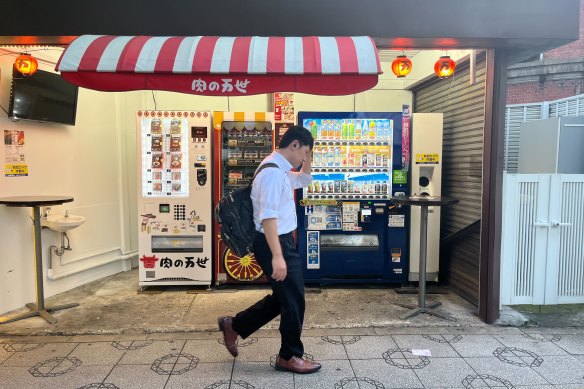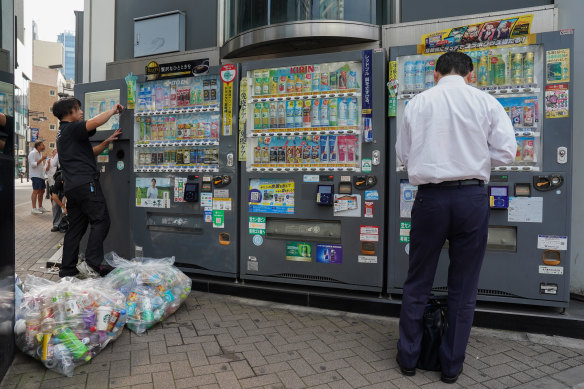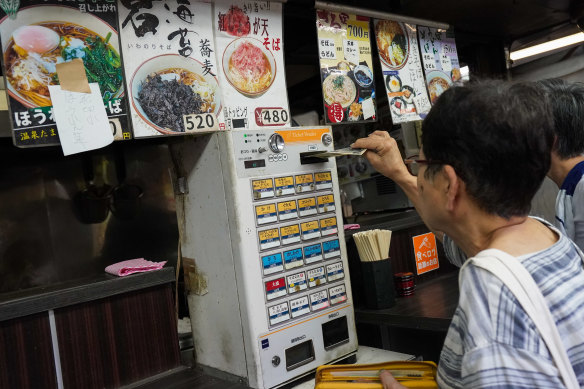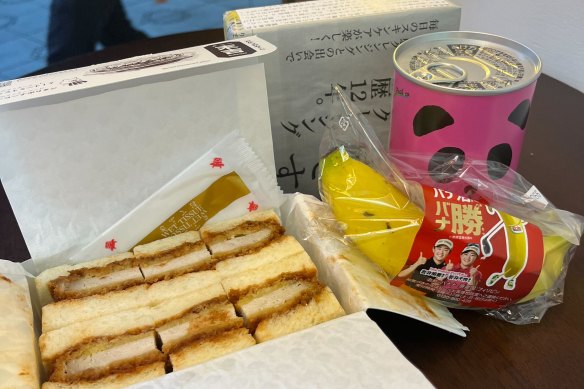By Lisa Visentin
What in the World, a free weekly newsletter from our foreign correspondents, is sent every Thursday. Below is an excerpt. Sign up to get the whole newsletter delivered to your inbox.
Tokyo: No city does sensory overload quite like Tokyo. From the crowd crush at Shibuya’s famously chaotic and neon-lit pedestrian crossing to the electronic jangle of flat-screen billboards lining Akihabara’s pulsating anime district and the gaudy technicolour fever dream that is Shinjuku’s karaoke and bar scene.

Vending machines in Tokyo’s Akihabara district where you can purchase katsu sandwiches, hamburgers and refreshments.Credit: Lisa Visentin
Tokyo’s visual vibrancy has long served as the gleaming facade of Japan’s reputation as being at the forefront of technological advancement and automation.
Beneath this high-tech veneer, however, aspects of the culture are still surprisingly antiquated. For example, Japan remains hooked on the fax machine, a technology obsolete in the West but used in Japanese government departments and owned by as many as one-third of households, while personal “hanko” ink seals are still used to stamp official documents and contracts.
At a street level, this contradiction of being simultaneously futuristic and outdated plays out in the humble vending machine.
To be a flâneur in Tokyo is to be constantly tempted by the convenience of a street-side refreshment from one of the city’s ubiquitous vending machines. Coffee, tea and soft drinks in a dazzling array of flavours at the very palatable starting price of 100 Yen ($0.96).

A row of vending machines in Tokyo’s Shibuya district.Credit: Christopher Jue
There are 3.9 million automated service machines located across the nation, of which 2.6 million are vending machines, according to data from the Japan Vending System Machine Manufacturers Association. That’s approximately one vending machine for every 48 people, the highest concentration in the world.
The vast majority of these dispense beverages. But it has become a popular quest among tourists and TikTokkers to track down the country’s weirdest vending machines, unearthing culinary curiosities like tinned yakitori chicken, edible insects, cake-in-a-can and even steaming hot ramen. On the non-edible front, you can find machines dispensing small gold bars and spruiking junk toys masquerading as mystery “treasure”.
But earlier this month, the Bank of Japan threw a spanner in the works for machine owners. It began issuing 1.6 trillion yen ($15.4 billion) worth of 3D hologram banknotes in 1000, 5000 and 10,000 yen denominations, the first renewal in 20 years.
As many as 80 per cent of the country’s vending machines are not equipped to accept the new banknotes, and there is a backlog in requests for manufacturers to upgrade machines to make them compatible.
“The manufacturers cannot catch up. It might take another month before ours is upgraded,” says Kakinuma, who runs an udon and soba noodle canteen in Tokyo’s Asakusa district.

The ticket vending machine at Kakinuma’s udon and soba noodle canteen in Tokyo’s Asakusa district does not accept Japan’s new 3D hologram bank notes.Credit: Christopher Jue
Even with the upgrade, he is unsure whether the new machine will take the old notes, which will remain in circulation.
His shop is one of many noodle restaurants that rely on a ticket-dispensing vending machine to serve customers. This automated system allows customers to choose their preferred meal from a machine typically at the front or outside the shop, feeding it yen in exchange for a ticket that is handed to a server before taking a seat in the restaurant.
In Japan, cash remains king. It trails other advanced economies in embracing cashless payment systems, and vending machines are predominantly powered by notes and coins. Many do not accept credit cards, though some accept digital payment through a prepaid “IC card” also used to access the train network.

Tokyo vending machine haul: a pork katsu sandwich, tinned strawberry cake, a banana and a mystery box containing biscuits and a typed message in Japanese. Credit: Lisa Visentin
On a derelict corner in Akihabara, a few blocks from the buzzing shopping district, is a stash of strange vending machines regularly dubbed by social media scouts as the “creepiest” in Tokyo. Great content for the ’gram, but not great for a bargain. For 1590 yen ($15.39) you can buy a plastic jar filled with large pinkish-coloured rocks, curiously sealed shut with yellow sticky tape and affixed with a handmade label claiming the contents as Mongolian rock salt.
I passed over this in favour of a $10 punt on a hot pink panda can that promised tinned strawberry bread, but delivered a dry tube of a pale starchy substance that tasted like it had a remarkably long shelf life.
I also took a $13 chance on a handmade paper box that, when unwrapped, revealed some salty animal-shaped biscuits and a typed note with musings on Japan’s housing crisis.
Possibly the same handiwork had been used to adorn the outside of the machine with labels warning that only old 1000 yen bills or coins would be accepted.
For those rocking up with the new bills (or even old bills, for that matter), I recommend crossing the street and getting yourself a pork sandwich from the katsu vending machine. For 800 yen ($7.74), the loin is juicy and tender, and the bread is soft and fresh.
And if you’re passing through Shibuya station, head to the basement for the banana vending machine. For 150 yen ($1.45) you get the spectacle of a single-issued fruit, dispensed perfectly ripened and chilled at 10 degrees.
Get a note directly from our foreign correspondents on what’s making headlines around the world. Sign up for the weekly What in the World newsletter here.